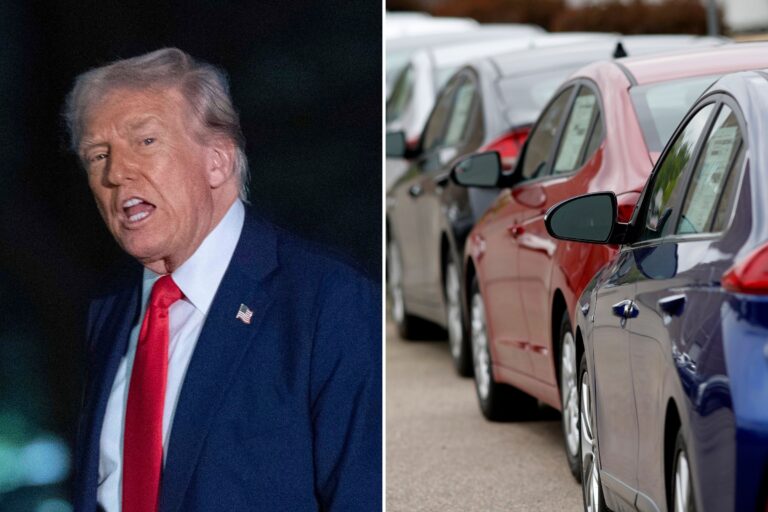President Donald Trump has announced a 25 percent tariff on all foreign-made automobiles and parts, marking a significant escalation in U.S. trade policy.
According to the White House, the move, enacted through a proclamation under Section 232 of the Trade Expansion Act of 1962, addresses “a critical threat to U.S. national security.”
Why It Matters
The newly announced tariffs are designed to redirect auto production to the U.S. by financially penalizing imports.

More
Jose Luis Magana left) and David Zalubowski (right/AP
The administration has said this approach will generate hundreds of billions in new revenue and reduce the national debt, while also incentivizing foreign and domestic manufacturers to increase local operations.
While some argue the tariffs could lead to a resurgence of American auto manufacturing and job creation, others caution that they could be inflationary, driving up vehicle costs for American consumers, and strain global trade relationships.
Given that most vehicles sold in the U.S. are made with a combination of domestic and imported parts, the new duties are expected to affect pricing and production strategies across the industry.
What To Know
On March 26, the president issued the proclamation and it is set to take effect on April 3 for vehicles and no later than May 3 for parts.
According to the White House, automobile importers working under the U.S.-Mexico-Canada trade agreement (USMCA) will have an opportunity to certify U.S.-based content to potentially reduce the duty burden on the North American auto trade.
USMCA-compliant automobile parts will remain tariff-free until the Secretary of Commerce, in consultation with U.S. Customs and Border Protection (CBP), “establishes a process to apply tariffs to their non-U.S. content.”
Newsweek has contacted the Department of Commerce via email for comment.
The tariffs apply to all imported passenger vehicles and light trucks, including sedans, SUVs, crossovers, minivans and cargo vans, and critical components such as engines and transmissions.
You can see the full list of vehicles sold in the U.S. that could be affected below. This does not include cars built in the U.S. that have foreign parts.
Trump said when announcing the tariffs that they would generate between $600 billion and $1 trillion in new revenue for the U.S. over the next two years, although White House staff secretary Will Scharf offered a lower estimate of $100 billion, CBS News reported.
The president said the revenue would be used to reduce the national debt, telling reporters, “Basically, I view it as reducing taxes and reducing debt.”
The White House emphasized that the move would secure a domestic industry it said had been eroded by decades of reliance on foreign supply chains.
In 2024, Americans bought about 16 million cars, half of which were imported, according to the White House. Of the 8 million vehicles assembled in the U.S., only 25 percent of their content was deemed “Made in America.”
The U.S. auto parts trade deficit also hit $93.5 billion in 2024, according to the White House.
The White House also noted that there had been a reduction of employment in automotive parts manufacturing. In 2024, there were roughly 553,300 jobs, and this was a decline of 286,000 jobs since 2000.
What People Are Saying
Ursula von der Leyen, the president of the European Commission, wrote on X, formerly Twitter, on March 26: “I deeply regret the U.S. decision to impose tariffs on EU automotive exports. Tariffs are taxes – bad for businesses, worse for consumers, in the U.S. and the EU. The EU will continue to seek negotiated solutions, while safeguarding its economic interests.”
Andy Palmer, former CEO of Aston Martin said: “Most car makers can’t eat 25 percent, they just can’t. That means car makers will pass on as much of the cost of tariffs as they can.”
Rella Suskin, an equity analyst at Morningstar, wrote in a research note cited by CBS News: “Domestically produced vehicles are expected to gain market share, but very few, even from U.S.-based manufacturers, are made with 100 percent U.S. content.”
Shawn Fain, the president of United Auto Workers, said in a statement: “We applaud the Trump administration for stepping up to end the free trade disaster that has devastated working class communities for decades. Ending the race to the bottom in the auto industry starts with fixing our broken trade deals, and the Trump administration has made history with today’s actions.”
Matt Blunt, the president of the American Automotive Policy Council, said in a statement: “U.S. Automakers are committed to President Trump’s vision of increasing automotive production and jobs in the U.S.”
What Happens Next
The implementation of the 25 percent tariffs is scheduled to begin on Thursday for imported vehicles, with duties on auto parts to follow by May 3. The administration has not ruled out the possibility of expanding the scope of the tariffs to include additional vehicle components.


